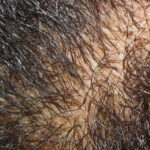Thinning of hair on the scalp can carry psychological consequences, such as depression and a loss of self-worth, for the individual experiencing it. While thinning of the hair is often thought of as a male affliction, women can also experience it. Hair thinning can be attributable to genetics, illness, and in some instances, to lifestyle. While there is no clear-cut answer on how to fully prevent thinning of hair on the scalp, understanding current scientific knowledge of the causes of hair thinning and how they may relate to prevention may help sufferers.
The most common form of hair thinning is known as androgenetic alopecia, and although the age of onset and severity can vary, it afflicts approximately half of all men by the age of 50 and approximately 25 percent of women over the age of 30. This type of hair thinning is inherited and thought to be brought about by excessive dihydrotestosterone (DHT) along its receptor in the scalp. DHT induces miniaturization of hair follicles, hence thinning of the hair.
Several recent genome-wide association studies have suggested that thinning of the hair, specifically via androgenetic alopecia, is a complex genetic trait. There is no way to prevent thinning of the hair caused by genetics. However, the FDA has approved two drugs, Minoxidil and Finasteride, to treat its progression.
A study in the British Journal of Dermatology suggests that 1 percent pyrithione zinc, commonly used to treat dandruff, may provide a mild benefit in treating androgenetic alopecia. However, its utility as a preventative agent is not clear and was not addressed by the study.
A study performed in Taiwan and published in the Archives of Dermatology associated smoking status with androgenetic alopecia in Asian men. This suggests smoking may be a modifiable risk factor for thinning of the hair. Smoking cessation will not only improve your health and well being, it may also help prevent the thinning scalp hair.
Several studies have suggested that anodrogenetic alopecia is linked to hypertension, cardiovascular disease, and insulin resistance, although the links between thinning of the hair and the ailments listed above have not been fully determined. A condition known as hyperaldosteronism is thought to drive both hypertension and thinning of the hair in some individuals.
Hair thinning can also be brought about by adverse drug reactions, anemia, illness, crash dieting and stress. This type of hair thinning is referred to as telogen effluvium. Dr. Marta Rendon, the Global Celebrity Dermatologist for Head & Shoulders, says, “Telogen effluvium can occur when a person experiences excessive stress and/or iron deficiencies, causing chronic hair shedding.” Further thinning can be prevented by treating the underlying cause.
Thinning of the hair can be complex in manifestation, whether it’s genetic, environmental, or a combination of the two. There is no magic bullet for the prevention of thinning of the hair, especially for the genetically predisposed individual. Treating the underlying causes of hair thinning, if disease- or stress-related, can be beneficial in preventing further thinning. Keeping one’s body in good health and reducing undue stress, such as crash dieting or smoking, may help prevent hair thinning or reduce its severity. While genetics and predisposition to certain diseases are impossible to overcome, self-induced damage to the body by lifestyle choice can be prevented.
References:
1. Stough, D., et al., Psychological effect, pathophysiology, and management of androgenetic alopecia in men. Mayo Clin Proc, 2005. 80(10): p. 1316-22.
2. Norwood, O.T., Incidence of female androgenetic alopecia (female pattern alopecia). Dermatol Surg, 2001. 27(1): p. 53-4.
3. Price, V.H., Treatment of hair loss. N Engl J Med, 1999. 341(13): p. 964-73.
4. Trueb, R.M., Molecular mechanisms of androgenetic alopecia. Exp Gerontol, 2002. 37(8-9): p. 981-90.
5. Hillmer, A.M., et al., Genome-wide scan and fine-mapping linkage study of androgenetic alopecia reveals a locus on chromosome 3q26. Am J Hum Genet, 2008. 82(3): p. 737-43.
6. Hillmer, A.M., et al., Susceptibility variants for male-pattern baldness on chromosome 20p11. Nat Genet, 2008. 40(11): p. 1279-81.
7. Richards, J.B., et al., Male-pattern baldness susceptibility locus at 20p11. Nat Genet, 2008. 40(11): p. 1282-4.
8. Mounsey, A.L. and S.W. Reed, Diagnosing and treating hair loss. Am Fam Physician, 2009. 80(4): p. 356-62.
9. Berger, R.S., et al., The effects of minoxidil, 1% pyrithione zinc and a combination of both on hair density: a randomized controlled trial. Br J Dermatol, 2003. 149(2): p. 354-62.
10. Su, L.H. and T.H. Chen, Association of androgenetic alopecia with smoking and its prevalence among Asian men: a community-based survey. Arch Dermatol, 2007. 143(11): p. 1401-6.
11. Arias-Santiago, S., et al., Hypertension and aldosterone levels in women with early-onset androgenetic alopecia. Br J Dermatol, 2009.
12. Gonzalez-Gonzalez, J.G., et al., Androgenetic alopecia and insulin resistance in young men. Clin Endocrinol (Oxf), 2009. 71(4): p. 494-9.
13. Lotufo, P.A., et al., Male pattern baldness and coronary heart disease: the Physicians’ Health Study. Arch Intern Med, 2000. 160(2): p. 165-71.
14. Sinclair, R., M. Wewerinke, and D. Jolley, Treatment of female pattern hair loss with oral antiandrogens. Br J Dermatol, 2005. 152(3): p. 466-73.
15. Futterweit, W., Polycystic ovary syndrome: a common reproductive and metabolic disorder necessitating early recognition and treatment. Prim Care, 2007. 34(4): p. 761-89, vi.
16. Hughes, E., Telogen Effluvium: Treatment & Medication. E-medicine. http://emedicine.medscape.com/article/1071566-treatment. accessed 1/24/2010





